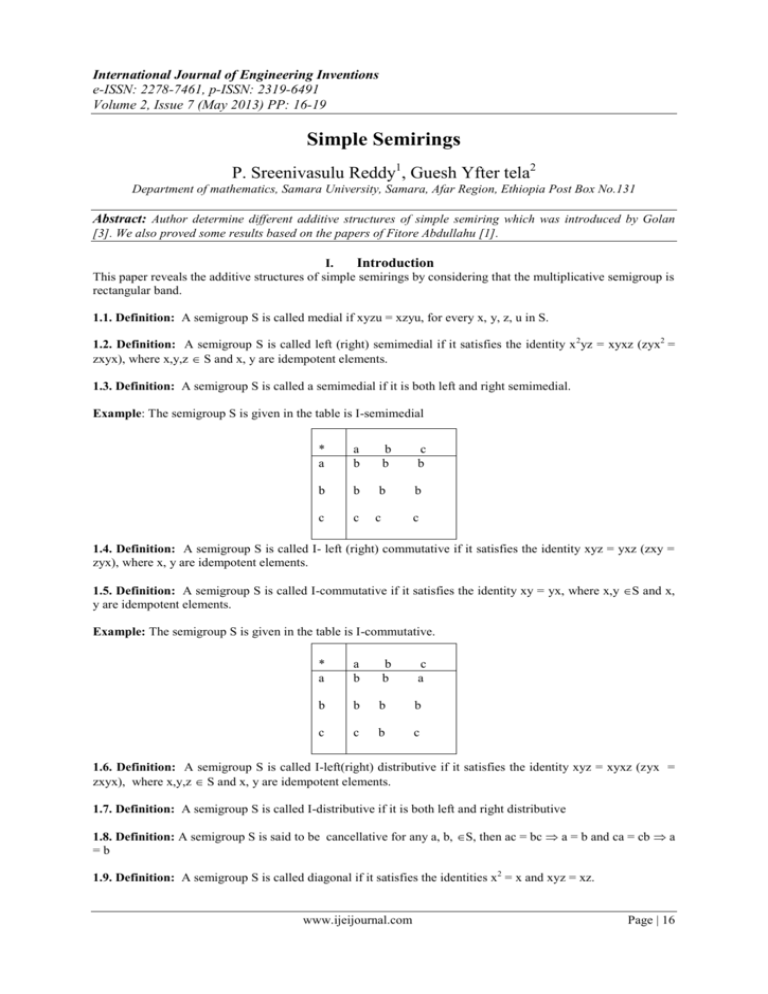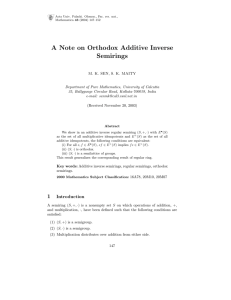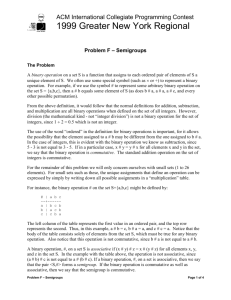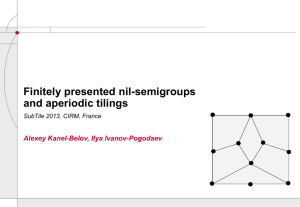Simple Semirings
advertisement

International Journal of Engineering Inventions
e-ISSN: 2278-7461, p-ISSN: 2319-6491
Volume 2, Issue 7 (May 2013) PP: 16-19
Simple Semirings
P. Sreenivasulu Reddy1, Guesh Yfter tela2
Department of mathematics, Samara University, Samara, Afar Region, Ethiopia Post Box No.131
Abstract: Author determine different additive structures of simple semiring which was introduced by Golan
[3]. We also proved some results based on the papers of Fitore Abdullahu [1].
I.
Introduction
This paper reveals the additive structures of simple semirings by considering that the multiplicative semigroup is
rectangular band.
1.1. Definition: A semigroup S is called medial if xyzu = xzyu, for every x, y, z, u in S.
1.2. Definition: A semigroup S is called left (right) semimedial if it satisfies the identity x 2yz = xyxz (zyx2 =
zxyx), where x,y,z S and x, y are idempotent elements.
1.3. Definition: A semigroup S is called a semimedial if it is both left and right semimedial.
Example: The semigroup S is given in the table is I-semimedial
*
a
a
b
b
b
c
b
b
b
b
b
c
c
c
c
1.4. Definition: A semigroup S is called I- left (right) commutative if it satisfies the identity xyz = yxz (zxy =
zyx), where x, y are idempotent elements.
1.5. Definition: A semigroup S is called I-commutative if it satisfies the identity xy = yx, where x,y S and x,
y are idempotent elements.
Example: The semigroup S is given in the table is I-commutative.
*
a
a
b
b
b
c
a
b
b
b
b
c
c
b
c
1.6. Definition: A semigroup S is called I-left(right) distributive if it satisfies the identity xyz = xyxz (zyx =
zxyx), where x,y,z S and x, y are idempotent elements.
1.7. Definition: A semigroup S is called I-distributive if it is both left and right distributive
1.8. Definition: A semigroup S is said to be cancellative for any a, b, S, then ac = bc a = b and ca = cb a
=b
1.9. Definition: A semigroup S is called diagonal if it satisfies the identities x2 = x and xyz = xz.
www.ijeijournal.com
Page | 16
Simple Semirings
1.10. Definition: A regular semigroup S is said to be generalized inverse semigroup if all its idempotent
elements form a normal band.
1.11. Definition: A regular semigroup S is said to be locally inverse semigroup if eSe is an inverse semigroup
for any idempotent e in S.
1.12. Definition: A regular semigroup S is said to be orthodox semigroup if E(S) is subsemigroup of S.
1.14. Definition: An element “a” of S is called k-regular if ak is regular element, for any positive integer k. If
every element of S is k-regular then S is k-regular semigroup.
Examples:
(i) If S is a zero semigroup on a set with zero, then S is 2-regular but not regular, has a unique idempotent
namely, zero but is not a group.
(ii) A left (right) zero semigroup is k-regular for every positive integer k but not k-inverse unless it is trivial. It is
to be noted that regular = 1- regular.
1.15. Definition: [3] A semiring S is called simple if a + 1 = 1 + a = 1 for any aS.
1.17. Definition: A semiring (S, +, .) is called an additive inverse semiring if (S, +) is an inverse semigroup,
i.e., for each a in S there exists a unique element a1S such that a + a1 + a = a and
a1 + a + a 1 = a1
Example: Consider the set S = {0, a, b} on S we define addition and multiplication by the following cayley
tables then S is additive inverse semiring.
+
0
0
0
a
a
b
b
a
a
0
b
b
b
•
0
0
0
a
0
b
0
b
a
0
0
0
b
b
0
0
b
1.18Definition: A semiring S is called a regular semiring if for each aS there exist an element xS such that a
= axa.
Examples: (i) Every regular ring is a regular semiring
(ii) Every distributive lattice is regular semiring.
(iii) The direct product of regular ring and distributive lattice is regular semiring.
1.19. Definition: An additive idempotent semiring S is k-regular if for all a in S there is x in S for which a + axa
= axa.
Example:
Let D be a distributive lattice. Consider S = M 2(D) the semiring of 2×2 matrices on D. Now consider
a b
c d
A=
a c
b d
. Then for. X=
A + AXA = AXA and this shows that S is k-regular.
1.20. Theorem: A simple semiring is additive idempotent semiring.
Proof: Let (S, +, .) be a simple semiring.Since (S, +, .) is simple, for any aS, a + 1 = 1. (Where 1 is the
multiplicative identity element of S. S1 = SU {1}.)
Now a = a.1 = a(1 + 1) = a + a a = a + a S is additive idempotent semiring.
1.21. Theorem: Every singular semigroup (S, +) is (i) semilattice
(ii) Rectangular band.
www.ijeijournal.com
Page | 17
Simple Semirings
1.22. Theorem: Let (S, +, .) be a simple semiring. Then S is regular semiring if and only if it is k-regular
semiring.
Proof: Let (S, +, .) be a simple semiring.Since (S, +, .) is a simple, for any aS, a + 1 =1.
Consider a = a.1= a(1 + b) = a + ab a = a + ab
Similarly, a = a + ba
Assume that S be a regular semiring. Then for any a S there exist an element x in S such that axa = a.
Now consider axa = a = a.1 = a(1 + x) = a + ax = a + a (x + xa) = a + ax + axa = a + axa axa = a + axa. Hence
(S, +, .) is k-regular semiring.
Conversely, assume that (S, +, .) be a k-regular semiring then for any aS there exist xS such that axa = a +
axa. Now consider a + axa = a(1 + xa) = a.1 = a axa = a S is a regular semiring
1.23. Theorem: Let (S, +, .) be a simple semiring. If (S, +, .) is k- regular semiring then S is additively regular
semiring.
Proof: Let (S, +, .) be a simple semiring.Since (S, +, .) is simple, for any aS, a + 1 = 1. Since S be a k-regular
semiring, for any a S there exist an element x in S such that axa = a + axa. To Prove that S is additively
regular semiring, consider axa = a + axa a = a + a (by Theorem 4.2.1.) (S, +) is a band
Since (S, +) is a band then clearly (S, +) is regular. Therefore S is additively regular semiring.
1.24. Theorem: If the idempotent elements of a regular semigroup are commutes then S is generalized inverse
semigroup.
Proof: Let S be a regular semigroup whose idempotent elements are commutes. Let x, y, z S and are
idempotent elements then xyz = xzy xxyz = xxzy xyxz = xzxy xyzx = xzyx. Hence idempotent
elements form a normal band. Therefore S is generalized inverse semigroup.
1.25. Theorem: Let S be a regular semigroup and E(S) is an E-inversive semigroup of S then i) E(S) is
subsemigroup
ii) S is an orthodox semigroup iii) E(S) is locally inverse semigroup.
Proof: (i) Let S be a regular semigroup and E(S) is an E-inversive semigroup. If a, b S then there exist some
x, y in S such that
(ax)2 = (ax) and (by)2 = (by), (xa)2 = (xa) and (yb)2 = (yb)
Let (axby)2 = (ax)2 (by)2 = (ax)(by) (axby)2 = (ax) (by).
(axby) is an idempotent of E(S).
Hence E(S) is subsemigroup of S and its elements are idempotents.
(ii) Since E(S) is a sub semigroup of S S is an orthodox semigroup.
(iii) To prove that eE(S)e is regular for some eS. Let f E(S) then
(efe)(efe)(efe) = efeefeefe = efefefe = efe (efe)(efe)(efe) = efe
Similarly (fef)(fef)(fef) = feffeffef = fefefef = fef (fef)(fef)(fef) = fef efe is an inverse element of E(S)
E(S) is locally inverse semigroup.
1.26. Theorem: Let (S, +, .) be a semiring. Then the following statements are equivalent:
(i) a + 1 = 1 (ii) an + 1 = 1 (iii) (ab)n + 1 = 1 For all a,b S.
Proof is by mathematical induction
1.27. Theorem: Let (s,+,.) be simple semiring. Then for any a,bS the following holds:
(i) a+b+1 = 1 (ii) ab +1 = 1.
1.28. Theorem: Let (S, +, .) be a simple semiring in which (S, .) is rectangular band then (S, .) is singular.
Proof: Let (S, +.) be a simple semiring and (S.) be a rectangualr band i.e, for any a, bS aba = a. Since S is
simple, 1+ a = a + 1 = 1, for all aS. To prove that (S, .) is singular, consider (1 + a)b = 1.b b + ab + b
= a (b + ab)a = ba ba + aba = ba ba + a = ba (b + 1)a = ba 1.a = ba a = ba ba = a (S, .) is
a right singular.
Again b(1+ a) = b.1 b + ba = b a(b + ba) = ab ab + aba = ab ab + a = ab a(b + 1) = ab a.1 = ab
a = ab ab = a (S, .) is left a singular. Therefore (S.) is singular.
1.29. Theorem: Let (S, +.) be a simple semiring in which (S, .) is rectangular band then (S, +) is one of the
following:
(i) I-medial (ii) I-semimedial (iii) I-distributive (iv) L-commutative
(v) R-commutative (vi) I-commutative (vii) external commutaitve
(viii) Conditional commutative. (ix) digonal
www.ijeijournal.com
Page | 18
Simple Semirings
Proof: Let (S, +.) be a semiring in which (S.) is a rectangular band. Assume that S satisfies the identity 1+a = 1
for any a S. Now for any a, b, c, d S.
(i) Consider a + b + c + d = a + (b + c) + b
(by Theorem.1.21. (ii))
=a+c+b+d
(S, +) is I- medial.
(ii) Consider a + a + b + c = a +(a + b) + c = a + (b + a) + c = a + b + a + c a + a + b + c = a + b + a + c (S,
+) is I- left semi medial.
Again b + c + a + a = b + (c + a) + a = b + (a + c) + a = b + a + c + a b + c + a + a = b + a + c + a (S, +) is
I-right semi medial.
Therefore, (S, +) is I-semi-medial.
(iii) consider a + b + c = (a) + b + c = a + a + b + c = a + (a + b) + c = a + (b + a) + c = a + b + a + c (S, +) is
I-left distributive.
Consider b + c + a = b + c + (a) = b + c + a + a = b + (c + a) + a =
b + (a + c) + a = b + a + c + a b + c + a = b + a + c + a (S, +) is Iright-distributive. Hence (S, +) is Idistributive.
Similarly we can prove the remaining.
1.30. Theorem: Let (S, +.) be a simple semiring and (S, .) is rectangular band then (S, +) is (i) quasi-seprative
(ii) weakly-seperative (iii) seperative.
Proof: Let (S,+, .) be a simple semiring and (S, .) is a rectangular band i.e, for any a,bS, aba = a. Since S is
simple, 1+a = a+1 = 1, for all aS. Let a + a = a + b a + a +1 = a + b + 1 a + 1 = b + 1 a = b. Again, a
+ b = b + b a + b + 1 = b + b + 1 a + 1 = b + 1 a = b. Hence a + a = a + b = b + b a = b (S, +) is
quasi-seperative.
(ii) Let a + b = (a) + b = ba + b = b + ab = b + a a + b = b + a→ (1)
From (i) and (ii) a + a = a + b = b + a = b + b a = b (S, +) is weakly seperative
(iii) Let a + a = a + b
b+b=b+a
From (1) a + b = b +a and from theorem 1.20 (S, +) is a band
Therefore, a = a + a = a + b = b + b = b a = b.
Hence (S, +) is seperative.
1.31. Theorem: Let (S, +, .) be a simple semiring in which (S, .) is rectangular band then (S, +) is cancellative
in which case |S| = 1.
Proof: Let (S, +, .) be a simple semiring in which (S, .) is rectangular band. Since S is simple then for any aS,
1 + a = a + 1 = 1.
Let a,b,c, S. To prove that (S, +) is cancellative, for any a, b, c S, consider a + c = b + c. Then a + c.1 = b +
c.1 a + c(a + 1)
= b + c(b + 1) a + ca + c = b + cb + c a + ca + cac = b + cb + cbc ( since (S, .) is rectangular ) a +
ca(1 + c) = b + cb(1 + c)
a + ca.1 = b + cb.1 a + ca = b + cb.1 a + ca = b + cb
(1 + c)a = (1 + c)b 1.a = 1.b a = b a + c = b + c
a = b. (S. +) is right cancellative
Again c + a = c + b c.1 + a = c.1 + b c(1 + a) + a = c(1 + b) + b c + ca + a = c + cb + b cac + c + a =
cbc + cb + b cac + ca + a = abc +cb + b ca(c + 1)+ a = cb(c + 1) + b ca.1 + a = cb.1 + b
a + a = cb + b (c + 1)a = (c + 1)b 1.a = 1.b a = b c + a = c + b a = b (S, +) is left
cancellative.
Therefore, (S, +) is cancellative semigroup. Since S is simple semiring we have 1 + a = 1 1 + a = 1 + 1. But
(S, +) is cancellative a = 1 for all aS. Therefore |S| = 1.
Reference
[1]
[2]
[3]
Abdullah, F. “Idempotent in Semimedial Semigroups”, International journal of Algebra, Vol.5, 2011, no.3, 129-134.
Abdullah, F. and Zejnullahu, A. “Notes on semimedial semigroups”, Comment.Math.Univ.Carlin.50, 3(2009) 321-324.
Golan, J.S. “The theory of semirings with applications in mathematics and theoretical computer science”, Pitman monographs and
surveys in pure and applied mathematics, II. Series. (1992)
www.ijeijournal.com
Page | 19









